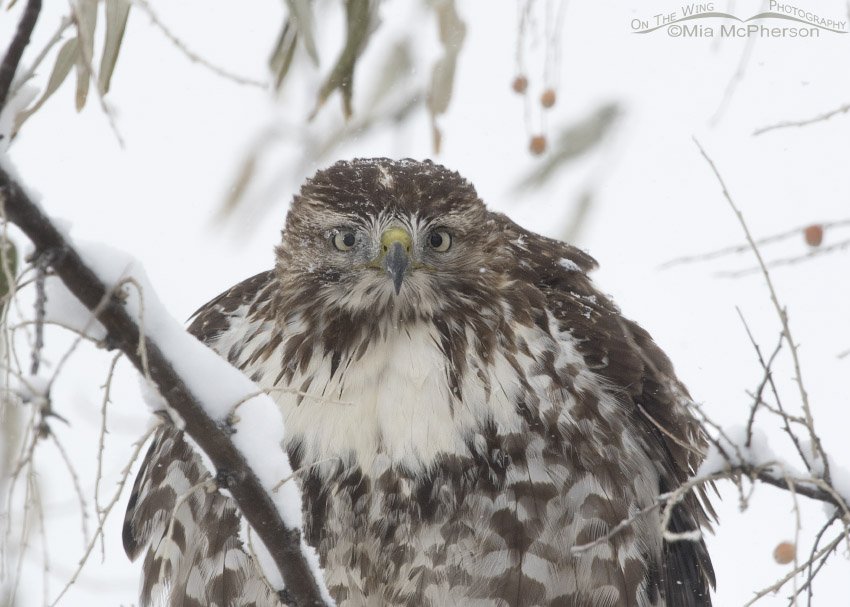 First year Red-tailed Hawk close up – Nikon D500, f7.1, 1/1250, ISO 640, +1.0 EV, Nikkor 500mm VR with 1.4x TC, natural light, not baited
First year Red-tailed Hawk close up – Nikon D500, f7.1, 1/1250, ISO 640, +1.0 EV, Nikkor 500mm VR with 1.4x TC, natural light, not baited
Even though the roads were dicey I did get out to photograph a few birds yesterday morning after our Christmas snow storm. At home there was probably close to 9 inches of the fluffy white stuff on the ground.
It was snowing at Farmington Bay, the light was low and visibility was poor but I didn’t come home completely empty-handed and I did see birds.
This first year Red-tailed Hawk close up in the snow storm was a reminder of how much our birds and wildlife have to struggle to get through the harsh winter. The juvenile hawk’s tail feathers were wet, its back had a fine layer of snow on it and there was ice on the feathers surrounding its right eye. It was also all fluffed up to keep out the cold.
This young hawk needs to be able to detect its prey in white out conditions with freezing temps and have successful hunts just to be able to survive the harsh winters here in northern Utah. Red-tailed Hawks, like many other raptors, suffer a high mortality rate of around 80% during their first year. If they can survive that first year they can live to be about 20 years of age.
This isn’t a great image because the snow-covered Russian Olive branches, leaves and fruits are a bit distracting to the eye and the white background isn’t the best but I think this photo speaks of the conditions this juvenile Red-tailed Hawk has to cope with to survive until spring. I hope this Red-tailed Hawk makes it.
Life is trying but good.
Mia
Click here to see more of my Red-tailed Hawk photos plus facts and information about this species.





Excellent Image, and for me, it does speak loudly. I think it is saying look at what I have to contend with..AND I think it also says what a great photographer you are.
Thanks for this intriguing image and fascinating details about the survival rate of these juveniles. I love your daily posts as I learn so much about birds, conservation and photography. Wishing you a wonderful New Year, Mia – may this be your BEST year yet!
Great image to illustrate the cold and snowy weather our distance relatives endure.
Not easy. A triumph of fortitude – and yes, I too hope this bird (and many others) does make it.
Beautiful image, glad you got out.
I love the eye contact. I also appreciate that you brought up the fact that survival in these conditions can be a struggle for all birds.It is always good to be on the watch for them.
Great image and a much needed reminder of the constant survival struggle for all wildlife.
That poor bird! I wish it lots of luck. Itvwill need it to find food, capture it and survive…so gew of these young ones do….
What a lovely and starkly real image, and yes, life can be a struggle at times. On the upside, feathers are miraculous at keeping birds warm or cool (depending on what’s necessary) and mostly dry. Thank you (and Ron) for heading out yesterday!
I love this photo. The bits you mentioned that are distractions really aren’t. In fact, I had to go back to the photo to see what I’d missed. You definitely know it’s cold & snowy.
I think that it is a great image, as it shows the real struggle our wildlife go through in harsh winter conditions, survival is not always pretty.
Thank you, Mia for the picture which may be lacking in photographically but speaks truly
about this bird and his life as well as that of other birds and animals.
Thank you for your posts and your comments. Keeps this old lady in the real world.
Hope there are many super photographic trips for you in the new year and that
the birds and animals you photograph survive and thrive despite our greed and ignorance.
Beautiful image, Mia. Takes a Die Hard Birder to do what you do.